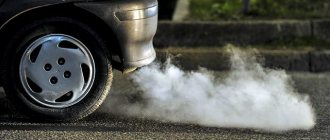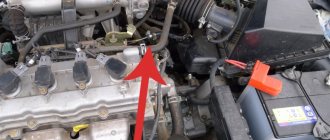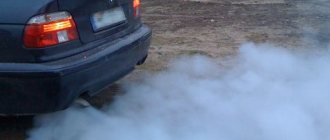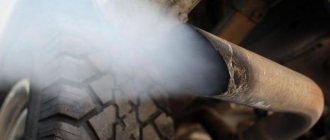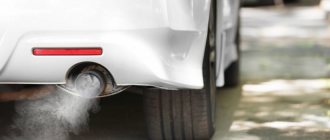20.05.2019
| (Votes: 8, Rating: 4.75) |
Issues discussed in the material:
- Why does thick white smoke come from the exhaust pipe of a gasoline engine?
- What can cause white smoke to come out of a diesel exhaust pipe?
- How to determine the cause of white smoke from the exhaust pipe of a gasoline engine
- How to Diagnose the Cause of White Smoke from a Diesel Exhaust Pipe
Usually in winter, most car owners do not pay attention to the fact that white smoke comes from the exhaust pipe. However, in the warm season, this looks at least strange, regardless of whether the car has a diesel or gasoline engine. The article talks about what the causes of strong white exhaust can be and how serious they are.
White smoke from the muffler - what is it?
A car - a harmonious system of components and assemblies - like a living organism, sends signals to the owner about various types of malfunctions. However, not every owner reacts to such a “trifle” as thick white smoke from the exhaust pipe of a gasoline engine. Meanwhile, the color of the exhaust, the frequency of the phenomenon (short-term or frequent) are harbingers of serious repairs: sometimes it comes to capital.
Exhaust gases consist of water vapor and many chemical compounds, the main ones being a mixture of nitrogen and carbon dioxide. Before being released into the atmosphere, spent substances are purified in a catalyst.
Why is white smoke from the exhaust pipe dangerous?
If the car is in order, the gases are colorless. A small cloud of whitish smoke when the power plant is cooling, as well as when starting the internal combustion engine in cold weather, should not bother the driver. Rather, steam is released: water, a byproduct of gasoline combustion, condenses in the cold exhaust tract and becomes visible. This picture is considered normal.
It’s worse when a dense white trail trails behind the car on a warm day, and the engine is warmed up to operating temperature. Analysis of the phenomenon in most cases indicates technical malfunctions of the vehicle.
What happens in the combustion chamber
As a result of combustion of a mixture of gasoline and air, carbon dioxide and water are formed. Nitrogen passes through the cylinders with almost no chemical reaction, and oxygen is completely consumed when the power system is properly adjusted.
High temperature allows water to be in the gas phase, that is, the steam is transparent. This happens until the amount of water per unit volume exceeds the maximum permissible threshold, beyond which partial condensation of steam begins, and additional substances, except air and gasoline, do not enter the cylinders. The condensation limit depends on the temperature; the higher it is, the more water the gases can hold without the appearance of small droplets of visible vapor. It is this steam that gives that characteristic milky color.
The main reasons for the appearance of white smoke from the exhaust pipe of a gasoline engine
It is important to be able to distinguish between harmless water vapor and smoke itself. The steam easily, without a trace, disappears into the air, while the smoke turns into an oily bluish fog behind the car. Let's consider the causes of white smoke from the exhaust pipe of a gasoline engine in order to correctly estimate the costs of restoring the mechanisms and systems of the car.
Leaking coolant cylinder
Drivers consider the cylinder block to be the most important component in the design of a car, which always requires attention.
The BC can depressurize for several reasons:
- gasket burnt out;
- the cylinder head was deformed due to improperly tightened nuts;
- A crack appeared in the cooling jacket of the unit.
The last trouble occurs due to the negligence of drivers who add cold water to a hot engine or defrost the unit when the thermometer is very negative. Antifreeze gets into the cylinders of a leaking block: white smoke comes out of the muffler. Other symptoms also appear:
- the motor lubricant becomes cloudy, a light yellow-brown emulsion appears in it, which is easy to notice in the filler neck;
- bubbles form in the expansion tank;
- the spark plugs get wet, smell like antifreeze, but sparkle like new: the working fluid cleans the parts perfectly;
- the power unit is tripping.
Causes of light white smoke
The danger of coolant leaking into the cylinders is that ethylene glycol (a component of antifreeze and antifreeze) mixes with the engine lubricant and forms solid particles. The latter, acting as an abrasive, destroys parts. And the lubricant loses its qualities. Taken together, these circumstances put the entire unit out of working order.
Injector malfunction
Both cars with injectors (Toyotas, Renault, Peugeot) and equipment with carburetors (motorcycles, walk-behind tractors, scooters) smoke.
The causes of white smoke from the muffler are as follows:
- the supply of the air-fuel mixture or the operation of the gas distribution mechanism is disrupted, which leads to incomplete combustion of gasoline;
- components of the cylinder-piston group are worn out;
- There were problems with engine cooling.
The last reason is the most likely for injection engines. Additionally you will notice:
- increased fuel consumption;
- oil zhor;
- floating speed;
- Difficulty starting an unheated unit.
The smoke from steam in injectors is characterized by high density, the smell of burnt oil, and long dissipation. It’s a completely alarming signal when the smoke does not disappear after the car warms up.
White smoke due to condensation
The exhaust tract, after standing overnight, becomes covered with drops of moisture. Condensation actively forms on metal in cool weather, when the thermometer is below +10 °C. High air humidity also contributes to the appearance of moisture in the muffler.
During the morning warm-up, the components of the exhaust system become hot, the exhaust gases mix with droplets of water, forming steam. As the condensate evaporates, the white smoke disappears.
Low-quality gasoline with foreign impurities
Some drivers save on gasoline or diesel and fill the tank with cheap fuel at dubious gas stations. So you risk paying for water that will freeze in winter and seal the fine mesh of the fuel filter, plus excess sulfur. In the combustion chambers, the substance turns into sulfur oxide, then, mixed with water vapor, into sulfuric acid. The consequences for the engine will be catastrophic.
The octane number in “left-handed” gasoline is not controlled, causing destructive detonation. And it contains toxic benzene and aromatic carbohydrates, which increase carbon deposits and “eat” rubber and plastic. Alcohols and ethers create air pockets in fuel lines.
Why does the chimney smoke white?
The following systems suffer from low-quality gasoline: intake-exhaust, fuel supply, exhaust, ignition. In addition to detonation, poor car starting, loss of power, you will hear knocking in the engine and see a darkish exhaust in the rearview mirror.
Oil burnout due to the presence of rings (smoke with a tint)
Remaining engine oil from valve stems and cylinder walls is removed by valve stem seals and rings. Worn rings become stuck, so excess lubricant burns out.
At the initial stage, the defect is noticeable when climbing uphill with the gas pedal pressed halfway. A bluish haze appears and quickly dissipates. In critical cases of oil scraper rings, smoke accompanies the car constantly, most of all when accelerating.
Moisture getting into the cylinders
By “moisture” we mean coolant. Look for the reasons why white smoke is coming out of the exhaust pipe in defects in the block or cylinder head. Most likely these are cracks.
For an accurate diagnosis, remove the cap from the expansion tank and start the engine. Now examine the fluid for oil stains and a specific exhaust odor. The detected signs indicate microcracks or wear of the BC gasket.
How to fix a fluid leak
Remove the cylinder head and block, inspect the gasket: most often the matter ends with replacing the consumables. Next, check the block for leaks: look for leaks near the valve seats, examine the cylinders one by one. If a leak is found, replace the defective parts.
However, the working fluid enters the cylinders in a different way - through the fuel intake system. It is difficult to detect the problem: there is no burning smell, the pressure is normal, but the lubricant turns into an emulsion, and the liquid level drops. There is no need to dismantle the cylinder head: inspect the intake manifold, find the place where the coolant leaks into the “pants”.
Possible causes of leakage of internal combustion engine circuits
The reasons for fluid entering from one independent circuit into another are usually associated with a violation of the integrity of the cylinder head gasket. The gasket has many holes with seals for the oil and coolant channels. It is most often subject to deformation and destruction as a result of engine overheating. As a result, the gasket cracks or the seal wears out, resulting in leaks. In particularly difficult cases, a crack may occur on the cylinder block body itself.
The coolant enters the combustion chamber. Its remains, which do not have time to evaporate and fly out into the chimney as white smoke, flow down the cylinder walls into the crankcase, diluting the oil. In addition to the above options for water getting into the oil, it is necessary to check all other possible causes.
Also, when diagnosing, it is recommended to pay attention to factors that could cause a significant increase in engine temperature. For example, incorrect operation of the thermostat, which also needs to be replaced along with the cylinder head gasket. Finding the cause of the malfunction will most likely require engine disassembly, as well as qualified specialists who have sufficient experience and knowledge to perform the task efficiently.
Why does white smoke appear from the exhaust pipe of a gasoline engine?
The exhaust tract is one of the mandatory modules of cars with internal combustion engines. In addition to the main task - removing exhaust gases - the system reduces noise from the operation of the internal combustion engine and the visibility of exhaust emissions. The latter, however, can be clearly expressed. Sometimes it’s just a physical law, in other cases it’s a signal of inevitable expensive repairs.
In the cold
If you start the car early in the morning at an ambient temperature below +8-10 ° C, then white smoke from the exhaust pipe of a gasoline engine will appear in the form of condensation in the metal pipes of the exhaust system. The phenomenon will become more noticeable the lower the thermometer drops.
Why did the car start smoking white?
The explanation is as follows: droplets of moisture (condensation) have settled on the inside of the muffler, the driver turns on the ignition, accelerates: hot gases rush into the pipe. The muffler heats up, the condensate passes into the gaseous phase - steam, visible to the eye.
On startup
And again physics - condensation in the muffler. Often there is so much moisture that it drips from the exhaust pipe. The shorter the trips and the more frequent the stops, the more intense the droplets are formed: in 15-20 minutes of driving the water will not evaporate completely. In the cold season, it is recommended to drive the car for at least half an hour every 7-10 days or warm it up thoroughly.
When warming up (hot)
When the car is completely warmed up and the cloud does not disappear, car mechanics advise making sure that antifreeze does not get into the combustion chambers. First you need to check the gasket, then the integrity of the cylinder head.
The causes of white smoke from the exhaust pipe of a gasoline engine when hot can also be:
- thermostat failure;
- inoperative fan;
- depressurization of the radiator and connecting hoses.
If a warm engine smokes, you won’t be able to ignore the problem: immediately diagnose the car and eliminate the defects.
When you accelerate
Look at the thermometer: if the mercury drops below +10 degrees, and it is damp outside, the natural process of evaporation of condensate comes into play. You press the gas pedal, more fuel mixture is injected into the combustion chambers. This means that the exhaust will be more energetic. The muffler gets very hot, moisture evaporates from the walls.
However, the picture changes in the warm season, when both temperature and air humidity are normal. You give it gas, but the white smoke from the exhaust pipe on a warm engine does not disappear. Urgently take the car to a car service center: most likely, the fault will be due to impaired coolant circulation.
At high speeds
You can't blame the weather if clouds of smoke are emitted through the exhaust pipe at high speeds. The reason may lie in the coolant, which has somehow penetrated the power system.
How to remove white smoke
Let's look at the problem in more detail.
Thick white steam does not stop and intensifies with increasing speed
In an automotive design, the channels of movement of the working fluid (antifreeze, antifreeze) pass quite close to the power unit. Under the influence of high temperature or vibration, the boundaries of the two systems are destroyed: serious malfunctions appear.
Fatigue of the gasket between the head and the cylinder block
The seal is the weak point of the cylinder head and the eternal concern of engineers. You can’t do without a removable head, so developers are constantly strengthening the gaskets. In “Mercedes”, “Lacetti”, “Mazda” the part is made as a composite part, consisting of several metal sheets. In this case, the gasket is firmly pressed with a dozen bolts. But temperature changes and metal fatigue lead to holes through which coolant at the inlet enters the combustion chambers.
In addition to white smoke from the muffler pipe, the phenomenon is accompanied by several characteristic signs:
- the expansion container “boils”;
- antifreeze constantly “disappears”;
- the engine overheats due to vapor locks even without heavy loads;
- The cabin heater does not heat properly;
- The radiator emits a slightly sweet smell.
An endoscopic examination or pressure testing of the cylinders with compressed air shows: the piston heads, washed with antifreeze, shine with cleanliness, which is far from the best indicator.
Gasket burnouts
Gaps in consumables appear if you have saved on it or violated the repair technology.
Advice from experienced people:
- take a high-quality critical part: do not use soft options edged around the combustion chambers (reinforced paronite) instead of the metal gaskets recommended by the manufacturer;
- do not reuse the part by patching burnouts;
- tighten the spare part with a torque wrench according to the instructions for the specific motor;
- do not rely on the tightening torque and tighten the part if required by the manufacturer;
- check for deformation and, if necessary, grind the planes of the head and block.
Non-standard gaskets quickly burn out and emit white smoke from the muffler.
Burnouts on the surfaces of the cylinder head and block
The cylinder block and cylinder head are two important components of a car's power plant. Between them there is a gasket, the reasons for the holes of which have already been discussed above. It remains to understand why the sealing of the components is still broken, due to which the coolant enters the combustion chambers, and a smoke trail stretches behind the car.
It's all about engine overheating, the list of reasons for which is not limited to one dozen:
- insufficient coolant;
- The radiator is not working efficiently (for example, the fan belt is loose);
- The thermostat has failed;
- the ignition angle is incorrectly set;
- prolonged detonation, one of the reasons for which is low-quality fuel;
- a lot of mineral salts from antifreeze or water have been deposited on the cylinder head cavity;
- uncontrolled independent use of additives in motor oil.
The lists can be continued, but the result is the same - the engine overheats, the surfaces of the block and cylinder head burn out, which is immediately indicated by white smoke from the exhaust pipe on a warm engine.
Corrosion and cracks
Rust on the surfaces of the block and head is an inevitable phenomenon. But microcracks – the entrance gates for coolant – also form quite often.
Causes of defects:
- the block was poorly washed and purged before assembly;
- vibration;
- air lock due to the fact that the expansion tank cap valve does not hold pressure;
- overheating of the engine with subsequent deformation.
How to detect cracks:
- Install magnets on the case, sprinkle metal shavings. The particles will move towards the magnet, getting lodged in the cracks.
- Wipe the surfaces with acetone, apply a special paint: when you wipe off the residue, the cracks will clearly appear.
Defects can be eliminated by electric or electric arc welding, epoxy paste, or patch welding. However, in some places (valve seats, cylinder mirrors, planes of connection between the block and the head) it will not be possible to repair cracks: the modules will have to be replaced.
What can the exhaust color say?
Based on the color of the exhaust gases, we can draw conclusions about the following violations in the operation of the engine:
- black exhaust – a combustible mixture over-enriched in fuel;
- blue exhaust – oil entering the combustion chamber;
- white exhaust means coolant has entered the cylinders.
One of the reasons for black exhaust is a too rich fuel mixture. An excess of fuel enters the cylinders, and it does not have time to completely burn during the engine cycle. Unburnt fuel products are emitted through the exhaust pipe in the form of soot particles. The causes of the problem may lie in both the injection system and the ignition system.
Often, an over-enriched combustible mixture is the result of severe contamination of the air filter, which leads to a significant lack of air for combustion. Perhaps the malfunction is due to incorrect operation of the nozzles or injectors and is associated with ineffective atomization of the mixture or “overfilling” of fuel. Often black exhaust smoke is accompanied by unstable engine operation and loss of power.
The uncharacteristic bluish or white color of the exhaust gases indicates the presence in the cylinders of those components that ensure the functioning of the engine, but under normal conditions remain isolated and do not participate in the combustion processes of the fuel mixture. This becomes possible if the tightness of one of the engine circuits - oil or cooling - is broken.
When foreign liquid enters the engine cylinders, its combustion products also give the exhaust gases a corresponding color. For example, the loss of engine oil is accompanied by a blue exhaust, and thick white smoke from the chimney is the result of coolant entering the combustion chamber.
How to determine why white smoke is coming from the exhaust pipe of a gasoline engine
Look into the expansion tank to see if there is any sediment or emulsion film there. Sniff: a foreign smell from the container is a bad sign.
Check the level and condition of the engine oil: there should be no water in the lubricant. Unscrew the spark plugs: carbon deposits are found - the fuel does not burn completely. Some experienced technicians, if the spark plugs are wet, taste the liquid on their tongue: a sweet taste means antifreeze has entered the system.
Paper check
Determine the nature of the exhaust (steam or smoke?) using a clean sheet of paper or a white napkin. Start the car and let the engine run for a short time. Bring the stored items to the muffler (do not lean close to it).
White smoke is pouring out
Examine the imprint left behind:
- if there is water in the pipe, the paper remains clean and will soon dry;
- if it is oil, you will see a greasy stain;
- Coolant will leave a blue or yellow mark.
The components on the napkin will emit a specific odor.
Emulsion on the lid
The coolant contains ethylene glycol. If, due to depressurization of the oil and cooling circuits, the components are mixed, an emulsion is formed. You can see the dangerous substance under the expansion tank cap: light foam or film will collect here.
What to do if the engine smokes when cold
Many new car owners ask what to do if the engine smokes when cold. I advise you to first see how it will behave when it warms up. If it continues to smoke when hot, then immediately take such a motor to a service center for repairs.
If it stops smoking, be sure to look at the color of the smoke next time. The shade depends on the breakdown of parts in the internal combustion engine. If there are any changes in the direction of enhancing the color scheme, or the smoke turns blue or black, then I recommend going to a service center. If it remains transparent, then nothing needs to be done.
If you are well versed in the insides of the engine, you can independently diagnose the rings and cylinders. Check if the air filter is clogged. Cylinder diagnostics are carried out as follows:
- Remove the spark plugs, wash and inspect them. Antifreeze usually washes the spark plug away from the faulty cylinder.
- Install the crankshaft until the intake and exhaust valves are in the closed position. Apply compressed air pressure through the spark plug. See if the coolant rises in the expansion tank. If yes, then this cylinder, for which the spark plug is responsible, is broken.
- Remove the cylinder head. Look at its gasket. If no faults are visible, then everything is fine with the cylinder head.
There are many other ways, but I still recommend contacting experienced mechanics.
Consequences for the engine if thick white smoke starts
Finding the cause of white smoke from the exhaust pipe of a gasoline engine is half the battle. It is important to understand the consequences and eliminate defects, since the latter quickly progress, destroying engine components.
With a thick white cloud astern, you can drive a few hundred kilometers: then you need to carry out detailed diagnostics of the power unit. At the initial stage, it may be necessary to replace the gasket, repair cracks in the block or head, and eliminate coolant leaks into the oil circuit. If you do not pay due attention to emissions from the exhaust tract, a major engine overhaul cannot be avoided.
Let's sum it up
Any problems with the car’s fuel system need to be repaired with the help of specialists. In modern cars, disassembling the engine in a garage can result in a real problem that will force you to urgently call specialists to troubleshoot problems. If you do not want to receive the unpleasant consequences of handicraft work, it is better to immediately contact a good service station for high-quality diagnostics.
There may be nothing wrong with the steam coming out of your car's chimney. But once again confirming the safety of operation with high-quality diagnostics will not be superfluous. Has a similar situation happened to your car and how did it end?

